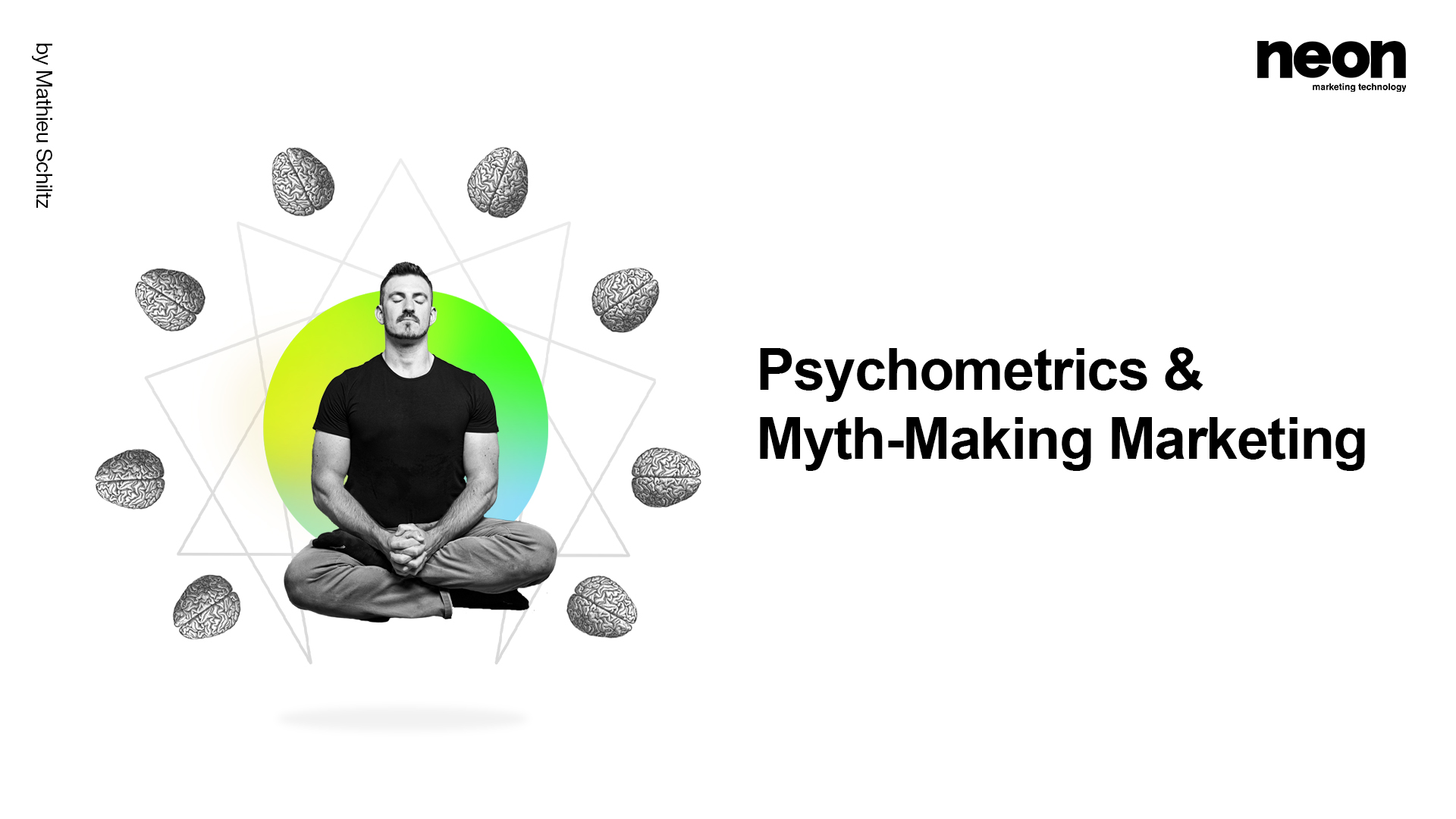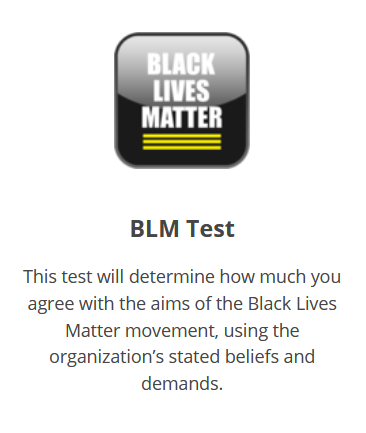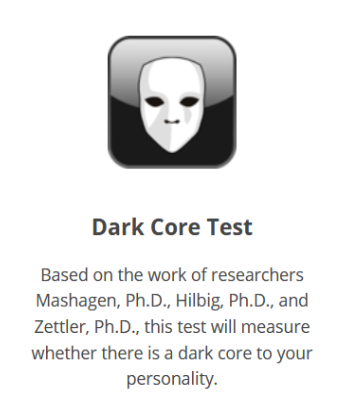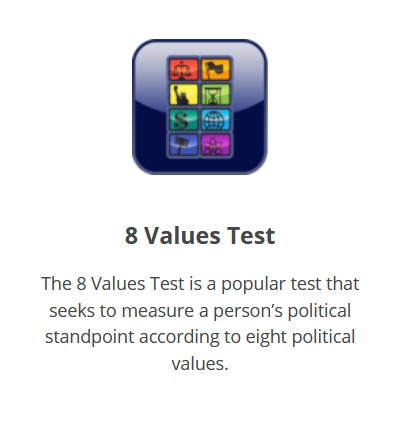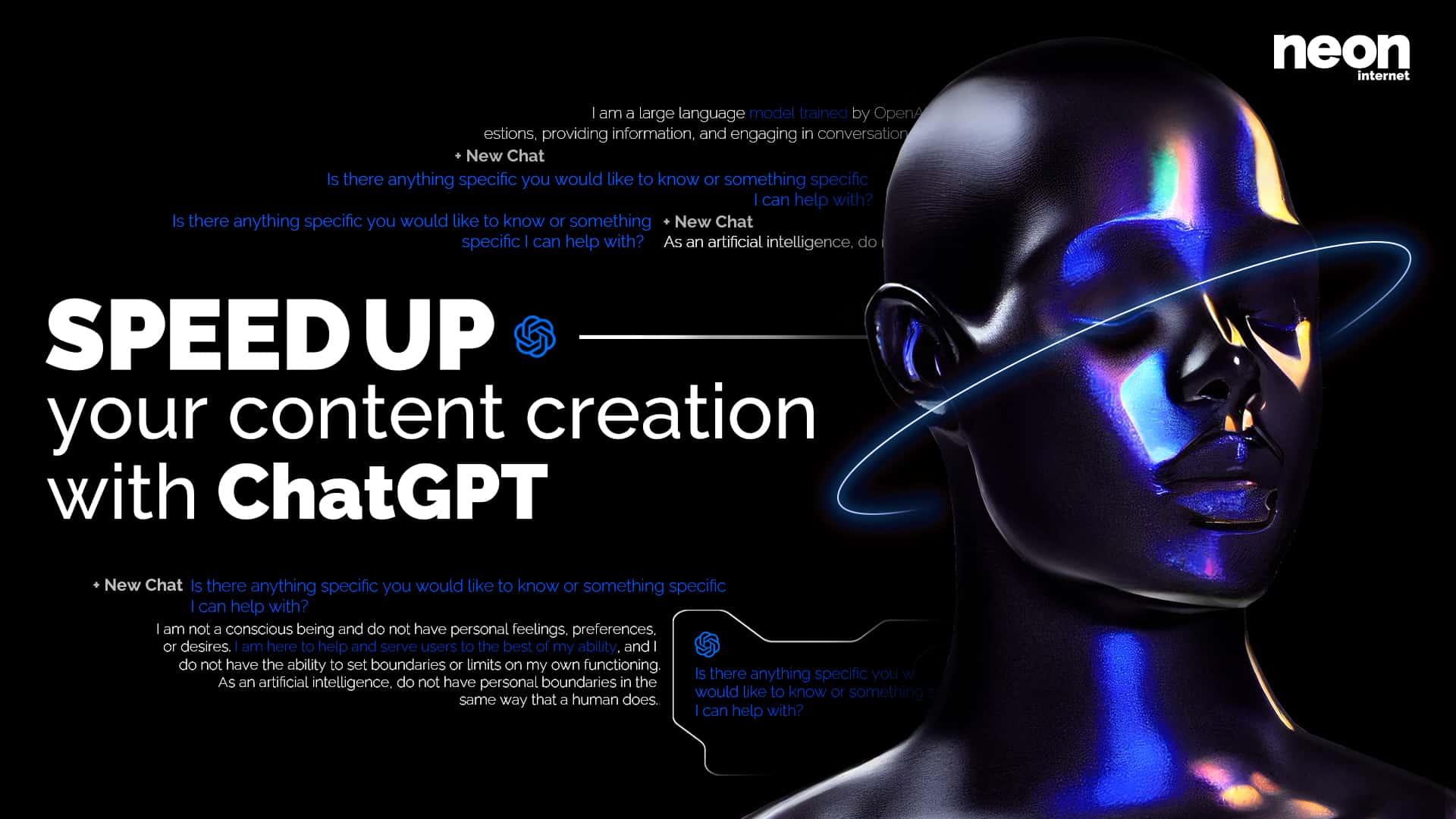Table of content
1. Psychometrics
2. Myth-Making Marketing
3. Conclusion
As a company obsessed with cutting-edge technology, we research every applicable topic to provide you with game-changing marketing tools and on-point consulting.
In an earlier blog post, we emphasized the importance of buyer personas. In this article we elaborate two similar, but slightly more complicated topics to you:
psychometrics and myth-making marketing.
(The density of the material on these topics made this turn into a longer and more theoretical post than usual).
1. Psychometrics
1.1. What are psychometrics?
Psychometrics are the art and science of systematic psychological measuring.
Systematic psychological measuring is all about quantifying and classifying the psyche.
The construction and application of measurement instruments is the key to psychometrics.
The classic psychometric instrument being the structured questionnaire with standardized answers.

Structured means that the questions are presented in a coherent framework.
Standardized means that the range of possible answers is fixed in advance.
These questionnaires are used for measuring all kinds of psychological or cognitive disposition in a person, like for example, personality or intelligence.
Intelligence being the best understood psychological construct in this day and age.
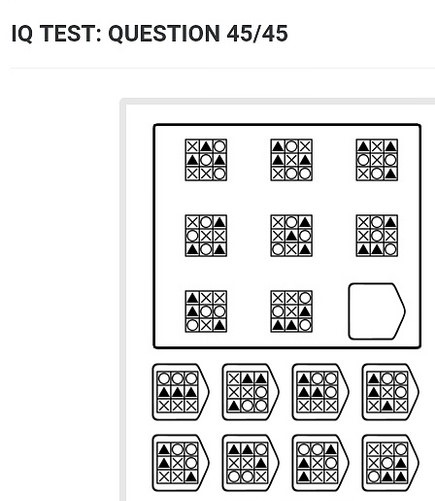
Psychometrics are commonly used in business to measure work-related cognitive capacities and psychological profiles.
It is business-practice to outsource recruiters, yet some more sophisticated companies build home-made aptitude tests around their unique job qualification requirements.
Psychometric tools to measure job aptitude are utilized by 80% of the Fortune 500 companies!
Among the most tested scales are cognition(IQ), personality, attention, perception, verbal communication, logical reasoning and visual-motor coordination.
Scientific personality tests ascertain data on character disposition and can grant insight into the work mentality and team compatibility of a person.
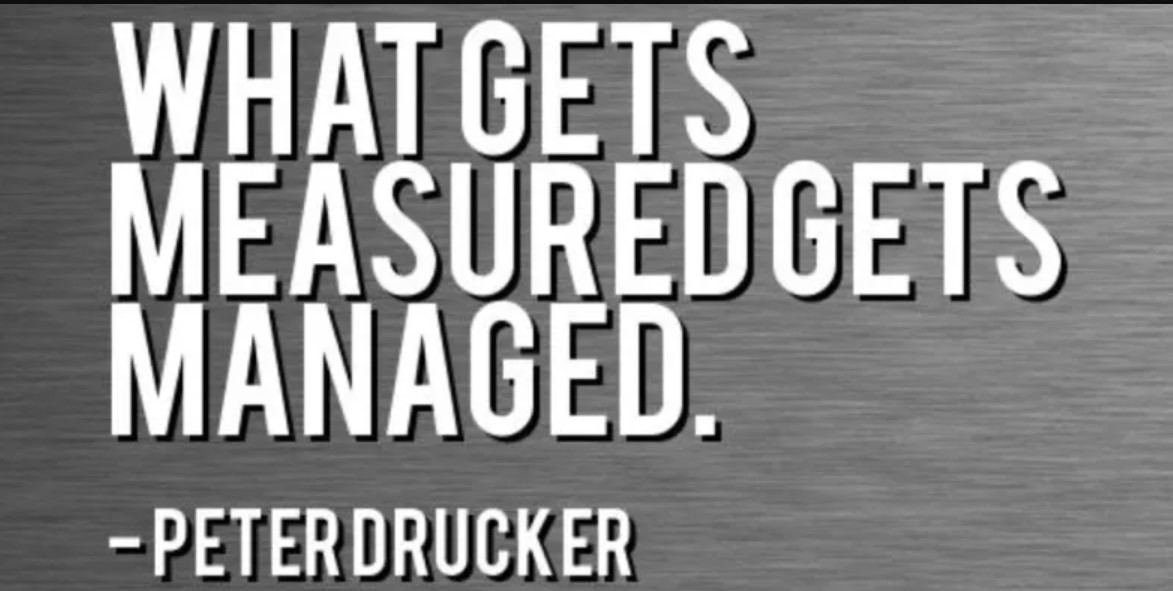
Besides recruiting, even the power of online marketing stems from the application of psychometrics.
Psychometrics can reveal hidden correlations between psychological factors and user activity/preferences beyond simple demographic profiling.
Any form of data-driven marketing has to be considered psychometric!
1.2. The Black-box model
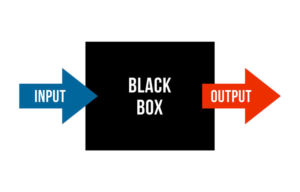
The Black-box model in marketing and psychology emphasizes our inability to understand the parameters of the human mind.
We can only control and measure the input stimuli and the output reaction, but not the black-box itself.
The input is the external stimuli (an ad, for example) we expose someone to and the output being the testee’s reaction to it.
Psychometrics rely on meaningful statistical correlations between input and output to unveil the black-box of the human mind.
In order to think out of the box you first need to understand the box.
Biology, neurology, and psychology are mapping the human psyche to understand human behavior better. Related fields like anthropology and sociology consolidate their research with the help of psychological models and theories: even cybernetics and information technology ultimately need to face the challenges the human mind poses.
The problem is of universal validity:
Decoding the human psyche is the holy grail of cognitive sciences.

Since marketing aims at influencing psychological attitudes and changing behavioral patterns, it is technically a form of applied psychology.
As such, it depends on a scientific model of the mind.
But: The primary goal of psychometrics in marketing is obviously not to find the ultimate theory of the human mind, but to re-create an operational model of the human mind in relation to your marketing channels.
Knowledge about the psyche is only fruitful if it converts into measurable business success.
In the digital age, the golden way of marketing consists of collecting meaningful data of users and interpreting it with a psychometric delicacy of feeling.
Psychometric marketing tools are the key.
1.3 Quality criteria of psychometric measuring

Good psychometric testing always complies to a series of standardized scientific quality criteria.
Here are the 3 fundamental qualities of well-founded psychometric testing:
1. reliability
Internal: consistency of the data and items of the measurement within itself.
Ex: If you split the item sets into two, do both halves predict the same results?
External: the extent to which a measure varies from one to another.
Does re-testing confirm the result? Do we all interpret the data in a similar fashion?
2. objectivity
Execution: Are the psychometric scales standardized?
Measurement: Do we have a systematic and consistent measurement method?
Interpretation: Does our interpretation of the data represent objective reality or personal bias?
3. validity
Construct: Does the test really measure what it is intended to?
Criteria: Do the criteria applied effectively predict real-world cases?
Apparent: Do the results make any sense whatsoever?

Psychometrics in online marketing don’t need to be in strict compliance with these criteria, however, they offer a great heuristic approach to the benchmarking of your instruments.
Last but not least, the administrative feasibility needs to be taken into consideration:
- Are the psychometric scales cost-effective?
- Do we have the required skill to administer psychometric testing?
- Do we have the required skill to program/create psychometric tools?
1.4 Personality tests
Intelligence tests are the most reliable psychometric tests around, yet their predictive validity is not perfect. The issue partly stems from defining intelligence beyond linguistic conventions, cultural bias, and a limited range of applications.
This problem is even amplified for personality tests.
There are numerous personality tests based upon various psychological models and personality typologies available on the market, among the 3 most famous being:
- the Five-Factor Model (OCEAN “Big Five”),
- the Minnesota Multiphasic Personality Inventory (MMPI),
- and the Myers-Briggs Type Indicator (MBTI).
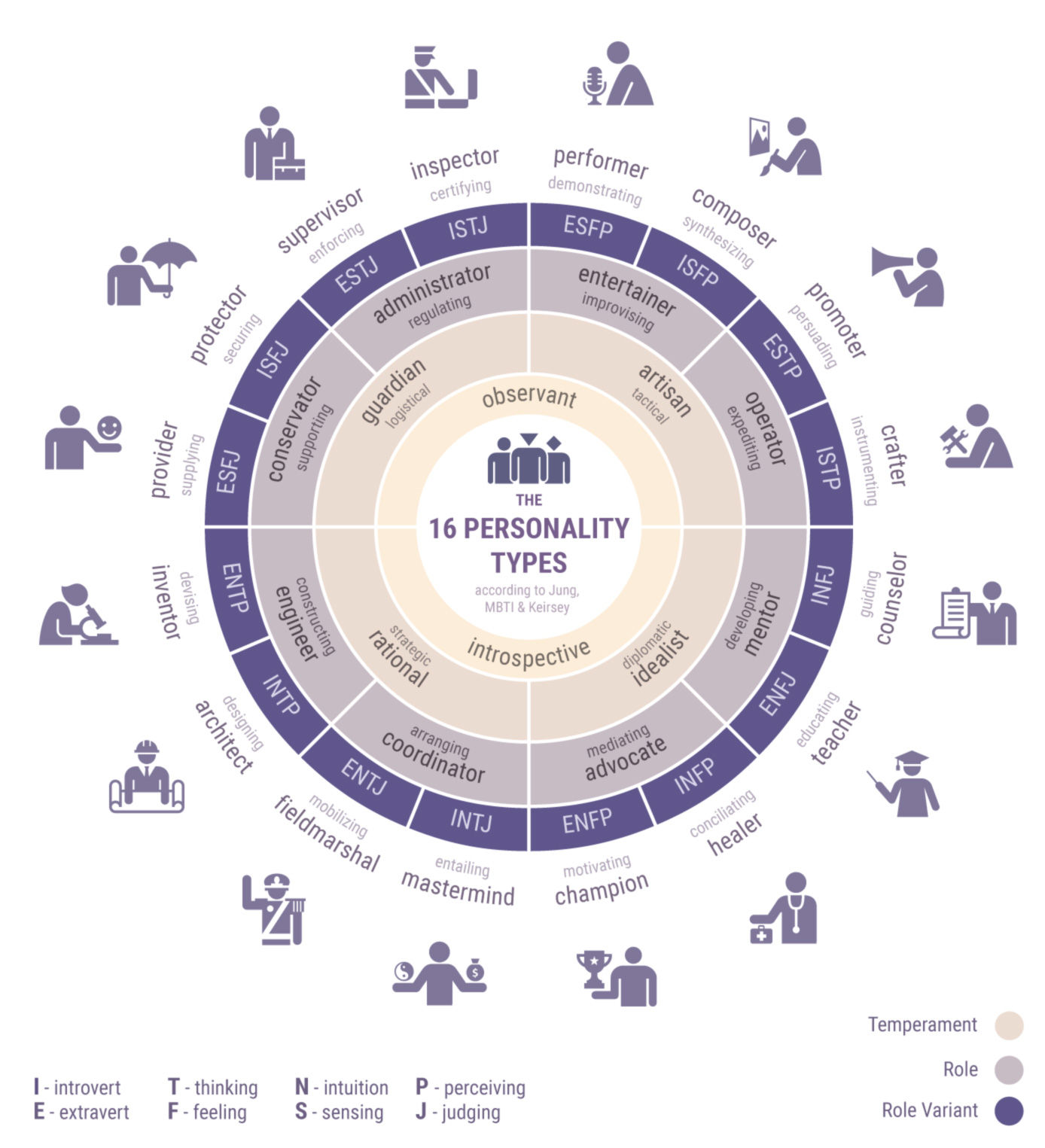
Source: Adioma
Personality tests are generally more prone to bias than IQ tests and vary significantly in the units and scales measured.
Whereas the “Big Five” measures five universal personality traits in degrees, the Myers-Briggs operates with 16 distinct character types.
The discriminatory power of the MBTI (Myers-Briggs) character-type matrix is therefore more difficult to prove scientifically.
For the same reason, the “Big Five” is deemed to be the most scientific of the above-mentioned tests. Its prognostic validity has been backed up by various statistical meta-analysis.
The MMPI has been very popular in clinical and forensic psychology but finds less application in the world of business psychology.
The MBTI is regarded as pseudo-scientific by scientists, yet it is being successfully used by many big, international companies.
It is crucial not to fall for bogus tests which don’t meet the scientific quality criteria.
But: Keep in mind that “scientific tests from the US” do not necessarily perform well in Europe or other areas!
Source: Enneagram Institute
The Enneagram typology test is based on 9 ideal role-types in social organizations which are conducive to synergistic effects.
This more holistic approach aims at identifying the characteristics and core competences of organization members in relation to the organization as a unit.
“The Whole is Greater than the Sum of its Parts”
The constructivist approach of this model implies that corporate identity is forged by the dynamic interaction of the team members.
Although this model generally fails to comply with the rigid quality criteria of science, it is fairly popular among companies in the US, South Korea, and Russia.
Repeatability is a key factor in science, yet the scientific method should not be undeservedly hailed as infallible. Science operates from paradigms which are prone to change over time.
In the final analysis, it is important to figure out which tests work best for your particular case.
Remember that regional characteristics, cultural personality norms, and many other confounding factors can easily impact the validity of psychometric scales.
The importance of the placebo effect must not be underestimated in this case: when organization members consciously accept a test, it is more likely to “work” and vice versa.
Source: IDRlabs
There is a panoply of scientific and unscientific psychometric personality tests available online. Scrolling through the tests shows you how different psychometric datasets can look like in practice. Although one should take the results (even of the scientific tests) with a grain of salt, it can serve as a great source of inspiration.
Psychometric data concerning political positioning has deemed to be crucial for political campaigning and personalized ads in general.
The Facebook-Cambridge Analytica data scandal revealed the power of psychometrics to the world. While only relying on activity data and a basic psychometric personality matrix like the “Big Five”, they managed to predict and manipulate the political orientation of millions of people.
Remember that filling out questionnaires generates a lot of sensitive data about you, which could be used to reconstruct your psychometric profile!
1.5 Hofstede’s Cultural Dimensions

Source: Hofstede
Hofstede defines culture as the collective mental programming of the human mind, which distinguishes one group of people from another.
Hofstede’s Cultural Dimensions are highlighting the differences and similarities between cultural values around the globe.
It is a psychometric tool to benchmark the psychological disposition of whole nations.
Gaps between the scores of the different items indicate cultural differences. The more significant the discrepancy, the more likely a cultural clash.
In this example, the “Long Term Orientation” and “Individualism” scores hint at possible incompatibilities between Luxembourg and the USA.
This insight can be used to adapt business strategies, communication styles, and so on to a new market and targeted audience!
1.6 The Quantified Self

A customer is not just a number, but a concrete, living person.
The Quantified Self-model is the radical opposite of the black-box, it assumes that it can understand a human being by systematic quantification of his/her features.
It is the quest for the “Quantified Self” which turned out to be the main venture of psychometrics.
Capturing a person in its cognitive abilities, personal characteristics and bio-metric data is a functional replication of the human identity.
This topic is so relevant that it has been picked up by most leading business psychologists and marketing analysts!
Note: At this point, it is crucial to mention that there are many competing schools of psychology and that there is no universal consensus on which psychological model effectively captures reality. Some see in the “Quantified Self” a wild fantasy of behavioral psychologists, while others believe that recent progress in methodology and technology bring us closer to actually realizing this vision.
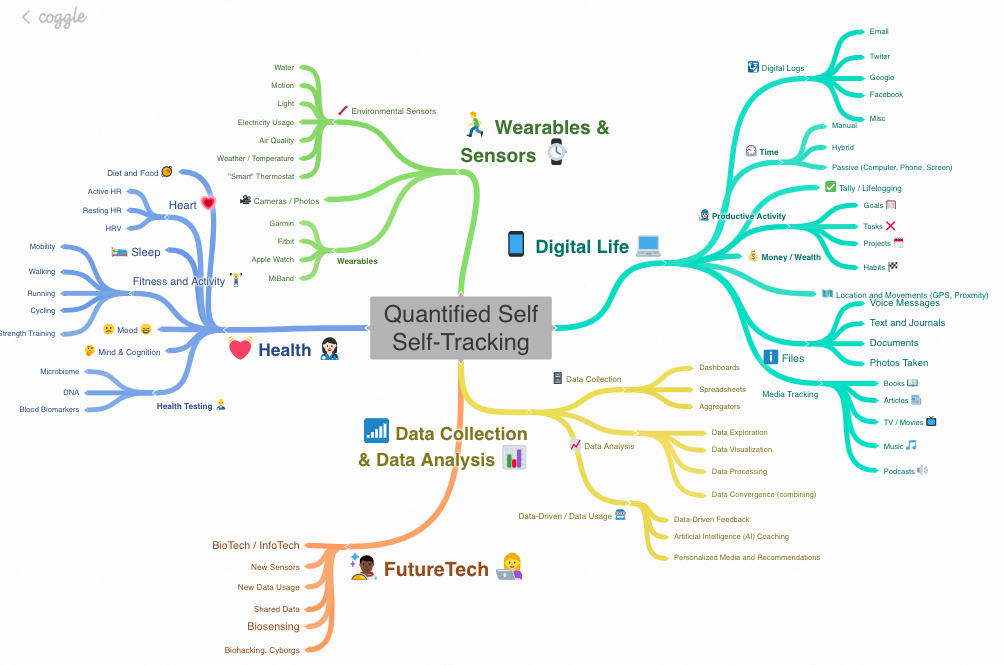
Source: Mark Koester
A systematic application of the Quantified Self model helps keeping track of user data and activity to optimize marketing strategies and choices!
Followers of the Quantified Self are often vilified as “data fetishists” since they advocate for complete measuring and mapping of the mind and body, which requires constant (self-)tracking, (self-)surveillance, (self-)monitoring.
The “data exhibitionism”-trend results in internet users willingly sharing crucial information about themselves.

The primary question posing itself here is whether it is possible for us to locate the dividing line between the psyche and the body (psychometric and biometric), private and public information.
Originally, the “Quantified Self”-enthusiasts were promoting a personal and voluntary data tracking lifestyle, but now the “Quantified Self” risks to become a more powerful version of the buyer persona in the hands of big industry and governments.
Major legal and ethical concerns must be raised here! The Quantified Self is a very powerful psychometric concept which needs to be treated with care!
1.7 The Digital Unconscious

Depth Psychology since Freud defines the personal unconscious mind as a reservoir of drives, feelings, thoughts, and memories outside of conscious awareness.
The Digital Unconscious is the sum of all the digital psychometric data which exists of a person outside of his/her conscious awareness.
Let’s assume an agent on the internet collects and interprets your activity data to assess your Quantified Self. If the agent is skilled enough to do so, (s)he is likely to end up understanding your online activity patterns better than you do yourself. The Digital Unconscious is the Achilles’ heel of every unaware internet user.
Do you have the habit of scrolling and browsing aimlessly through the internet? Maybe there is a pattern underlying your activity, but you just haven’t noticed yet.
Jacques Ellul famously said that reflexes replace reflection, which means that compulsive behavior dominates over rational behavior.
Generally speaking, the more impulsive your online activity is, the easier it is to target and arouse your desires.
The efficiency of the AIDA-Model (Attention, Interest, Desire, Action) in Marketing is largely due to the unconscious reception of ads by people!
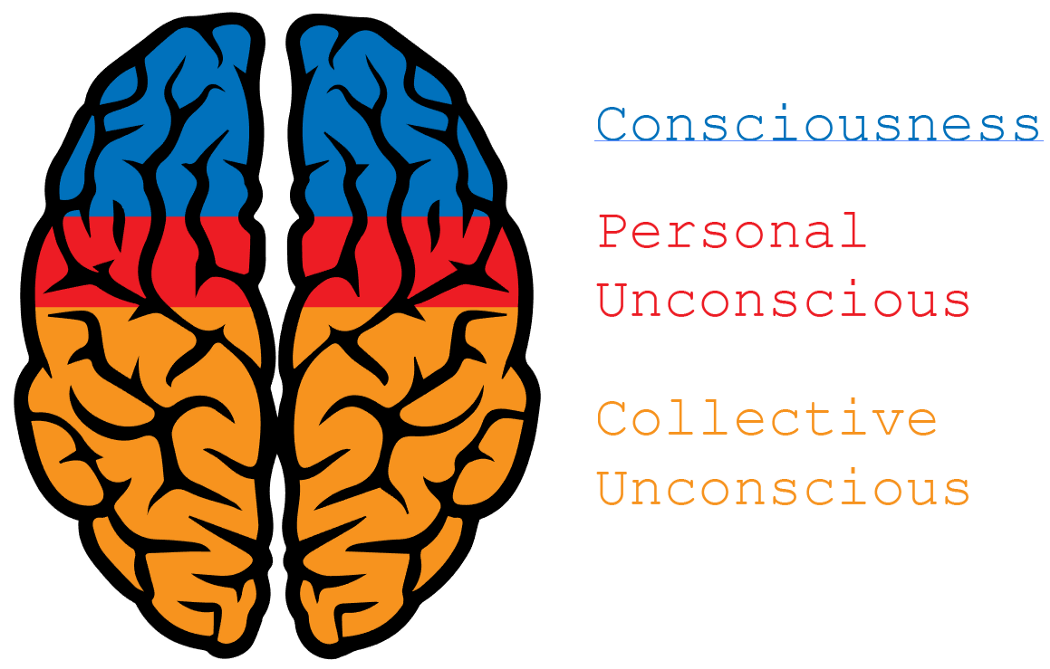
If we postulate the existence of a Jungian collective unconscious, the boarders of the Digital Unconscious are completely rendered void.
The implications of this have yet to be grasped.
The Quantified Self could eventually assume the shape of a “Quantified Hive” since the overall personal data could be integrated into an all-encompassing collective matrix.
For now, there is a lot of speculation about whether AI is capable of achieving total predictive power over the human hive.
As a matter of fact, a common denominator at the root of the unconscious of mankind exists: the affinity for mythical meta-narratives.
2. Myth-Making Marketing
We at Neon keep on reminding you to create value and tell a story.
This time we want to add a third point to it: make a myth.
The term “myth” obviously does not mean “false” in this case. Quite the opposite, a myth is a deep and meaningful narrative.
The Ancient Greek myth of Psyche and Eros is the archetype of the relationship between psyche and desire. After going through hardship and suffering for their love, the story ends with Psyche and Eros getting happily married.
This myth contains a fundamental fact of marketing: sex/love/emotion sells.
Storytelling in marketing is re-enacting the mythical psychodrama of Psyche and Eros. The wisdom lies in inspiriting your product with a meaningful quest.
The attainment of the object of desire results in psychological gratification (happiness, satisfaction, confidence, self-actualization, self-esteem, peer attention, flow, etc.).
Myth-Making Marketing starts from the depths where brands need to translate their mission into a myth. Connecting the stories to a deeply rooted myth looks like an inverted iceberg: only 20% of the myth is “visible” through the stories, and 80% is hidden down below, yet you can tease and pull many costumers in.
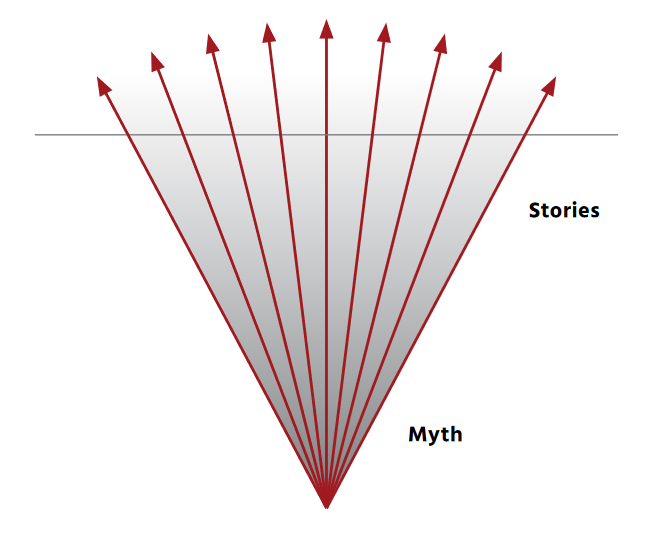
Source: Schaefer/Kuehlwein
Ultimately it is the audience deciding whether a brand story becomes mythical or not.
If consumers don’t “hold the belief” or embrace a narrative as meaningful, a brand will fall short of “mythical power”, no matter how beautifully its story is spun.
“When a person(/brand) becomes a model for other people’s lives, he has moved into the sphere of being mythologized.” Joseph Campbell
Successful marketing is more than just manipulating people’s attitude towards a brand or product- it is the crafting of a new identity which gives the product a special intrinsic value.
This is why we call it “Myth-Making Marketing”, because it links our brand or product with the costumer’s own self-actualization.
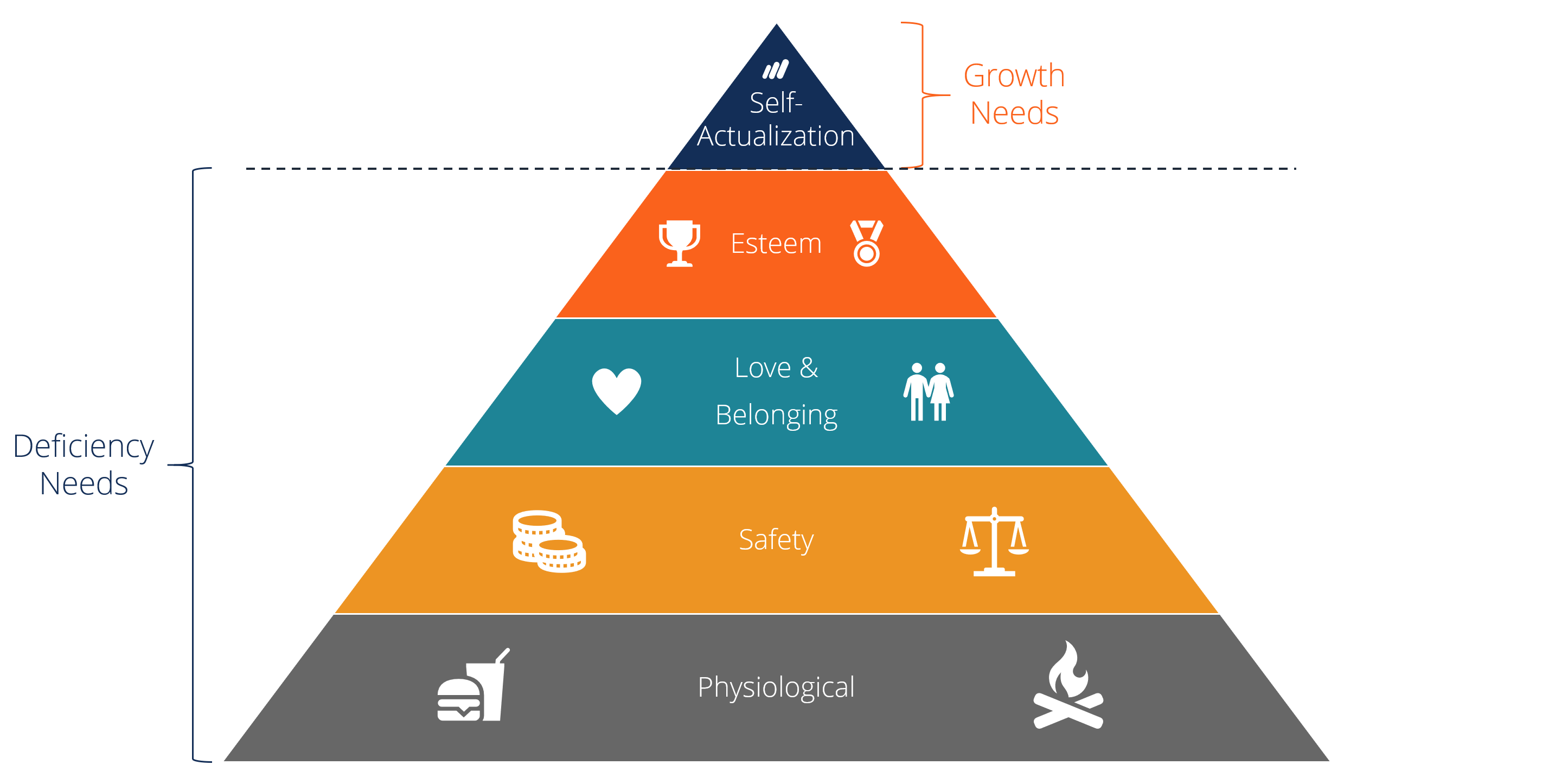
Source: Maslow’s Hierarchy of Needs
FMCG (Fast Moving Consumer Goods) generally don’t suit this kind of “mythological” branding, since they rarely manage to fulfill our growth needs.
What matters from the psychometric perspective is that our marketing strategy ultimately leads to a certain behavior (activity, purchase, loyalty) and attitude (product associations) which we measure!
Self-actualization is the re-branding of the Self: the product becomes the conveyor of a new personal identity.
“The most important question anyone can ask is: What Myth am I living?”
C.G. Jung
![]()
Source: Iconic Fox
Brand Archetypes are used to pick the right associative values for a company or a product.
These archetypes are the ideal representation of the roles and functions of human personality in storytelling/myth-making.
Sometimes, obvious brand archetype choices in relation to our product/service offer themselves to us.
Example: Emulate the myth of the Explorer when you sell backpacks.
Archetypes are expressed in all forms of creative expression throughout the ages and among every civilization.
Jung’s theory suggests that the emergence of these universal patterns in our unconscious mind serve an evolutionary purpose.
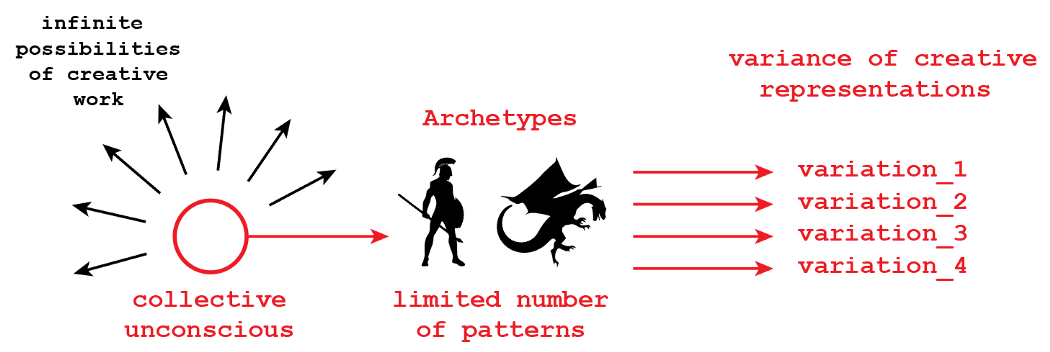
Source: Michelangiolo Mazzeschi
The omniscience of the Dragon archetype in the East and West hints at humans being “neurologically hardwired” to these pre-existing mental structures.
Since the amount of archetypes is limited, we can’t but derive our representations from these fundamental patterns which are guiding the myth-making process.
In practice, the prevalence of patterns means that AI-driven tools could perform very well in this domain.
To start a branding process from the scratch implies the necessity of emulating archetypes.
The Sage, for example, is the old wise man: his function is to educate and guide the people. This archetype exists in almost every culture and thus conveys a universal, symbolic message.
But: For Cross- or intercultural marketing, it is indispensable to identify the archetype and adopt a culture-specific representation to ascertain successful branding.

Gandalf

白眉(BaiMei)
Since Lord of the Rings is fairly popular in China and BaiMei has been immortalized by Tarantino’s Kill Bill in the West, there is a certain “cross-cultural compatibility” between Sage figures such as Gandalf and BaiMei.

Christian missionaries, however, adapted their message to local parameters by “re-branding” their iconography. Christ is represented as ethnically Asian/African or Caucasian respectively.
Assimilation vs. Differentiation are the two strategies to choose from.
It is paramount to understand the culture, myths and symbols of people in order to find the best possible Brand Archetype.
3. Conclusion
Let’s recapitulate the essential beliefs we communicate in this article:
- We believe that psychology, more precisely psychometrics, can provide a framework to interpret user data more accurately for marketing purposes.
- …that good marketing basically implies good psychology.
- …that psychometric tools have the power to help us understand ourselves and our customers better.
- …that psychometric testing is a key method to take the right decisions.
- …that we are entering a new epoch in the age of psychological profiling, namely the age of the Quantified Self.
- …that we have a digital unconscious which can be deciphered using psychometric techniques.
- …that psychometrics pave the path for an innovative marketing style which we dubbed “Myth-Making Marketing”.
- …that appropriate ethical concerns must be raised given the power of these instruments.

